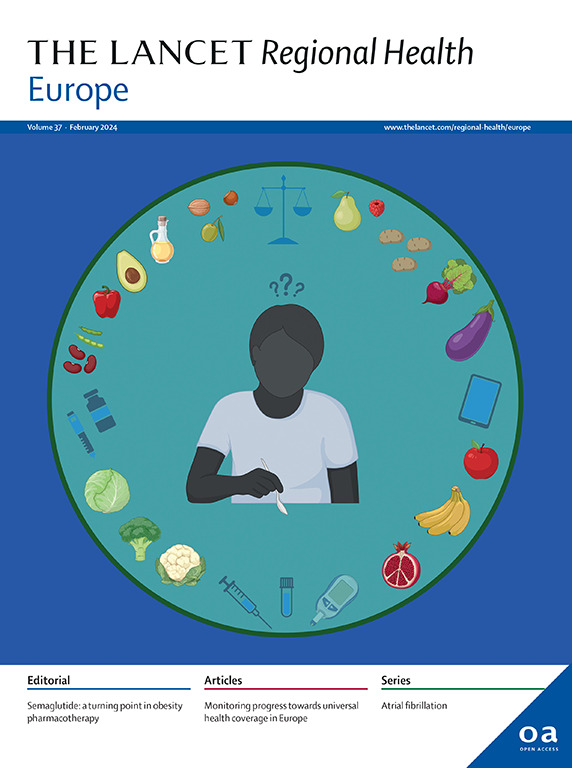Estimating the impact of displacement from Ukraine on HBV and HCV prevalence among migrants in the European Union, 2024: a modeling study
IF 13
Q1 HEALTH CARE SCIENCES & SERVICES
引用次数: 0
Abstract
Background
In countries with low baseline burdens of hepatitis B and C viruses (HBV, HCV), high levels of migration can impact the burden of viral hepatitis. The screening and treatment of migrants requires different methods and sensitivities than broad-based programs. We aimed to estimate the prevalence of HBV and HCV among migrants in EU-27 countries in 2024. The Ukrainian Refugee Crisis was also quantified.
Methods
Using the United Nations 2024 migrant stock data, we estimated the migrant population for each EU-27 country by five-year age and sex cohorts by country of birth. These distributions were multiplied by five-year age and sex prevalence estimates in the country-of-birth models maintained by the Polaris Observatory. The difference between the 2024 and 2020 Ukrainian migrant stock was quantified to estimate the impact of the Ukrainian Refugee Crisis.
Findings
In 2024, there were an estimated 1.73 million (UI: 1.04–2.66 million) migrants living with HBV and 1.03 million (UI: 757,000–1,559,000) living with anti-HCV in the EU-27, corresponding to migrant prevalences of 2.73% (UI: 1.6–4.2%) and 1.53% (UI: 1.2–2.5%) respectively. The Ukrainian Refugee Crisis is estimated to have resulted in an additional 43,000 (UI: 28,700–60,900) migrants living with HBV, and 154,000 (UI: 12,500–202,000) with HCV in the EU-27.
Interpretation
The burden of HBV and HCV among migrants and which communities are most affected in the EU-27 at the national level are vastly heterogeneous. These data provide evidence for policy makers to better understand the burden their community faces so that they can be better poised to develop culturally appropriate materials and outreach. While there is a great deal of uncertainty regarding the number of migrants by country, as well as the prevalence among these groups, this work provides direction towards which groups are most likely impacted at the EU-27 and national level.
Funding
John C Martin Foundation.
估计乌克兰流离失所对2024年欧盟移民中HBV和HCV患病率的影响:一项建模研究
背景:在乙型和丙型肝炎病毒(HBV、HCV)基线负担较低的国家,高水平的移民可能会影响病毒性肝炎的负担。移民的筛查和治疗需要不同的方法和敏感度,而不是基础广泛的方案。我们的目的是估计2024年欧盟27国移民中HBV和HCV的患病率。乌克兰难民危机也被量化了。方法使用联合国2024年移民存量数据,我们按5岁年龄和性别队列按出生国估计每个欧盟27国的移民人口。在北极星天文台维护的出生国模型中,这些分布乘以5年的年龄和性别患病率估计。对2024年和2020年乌克兰移民存量的差异进行量化,以估计乌克兰难民危机的影响。研究发现,2024年,欧盟27国估计有173万(UI: 1.04 - 266万)移民携带HBV, 103万(UI: 757000 - 155.9万)移民携带抗hcv,相应的移民患病率分别为2.73% (UI: 1.6-4.2%)和1.53% (UI: 1.2-2.5%)。据估计,乌克兰难民危机导致欧盟27国新增43,000名(死亡人数:28,700-60,900)移民感染HBV, 154,000名(死亡人数:12,500-202,000)移民感染HCV。在欧盟27国,移民中HBV和HCV的负担以及受影响最大的社区在国家层面上存在很大差异。这些数据为政策制定者更好地了解其社区面临的负担提供了证据,以便他们能够更好地准备制定适合文化的材料和推广活动。虽然各国的移徙人数以及这些群体的普遍程度有很大的不确定性,但这项工作为在欧盟27国和国家一级哪些群体最有可能受到影响提供了方向。资助约翰·C·马丁基金会。
本文章由计算机程序翻译,如有差异,请以英文原文为准。
求助全文
约1分钟内获得全文
求助全文
来源期刊

Lancet Regional Health-Europe
Multiple-
CiteScore
19.90
自引率
1.40%
发文量
260
审稿时长
9 weeks
期刊介绍:
The Lancet Regional Health – Europe, a gold open access journal, is part of The Lancet's global effort to promote healthcare quality and accessibility worldwide. It focuses on advancing clinical practice and health policy in the European region to enhance health outcomes. The journal publishes high-quality original research advocating changes in clinical practice and health policy. It also includes reviews, commentaries, and opinion pieces on regional health topics, such as infection and disease prevention, healthy aging, and reducing health disparities.
 求助内容:
求助内容: 应助结果提醒方式:
应助结果提醒方式:


